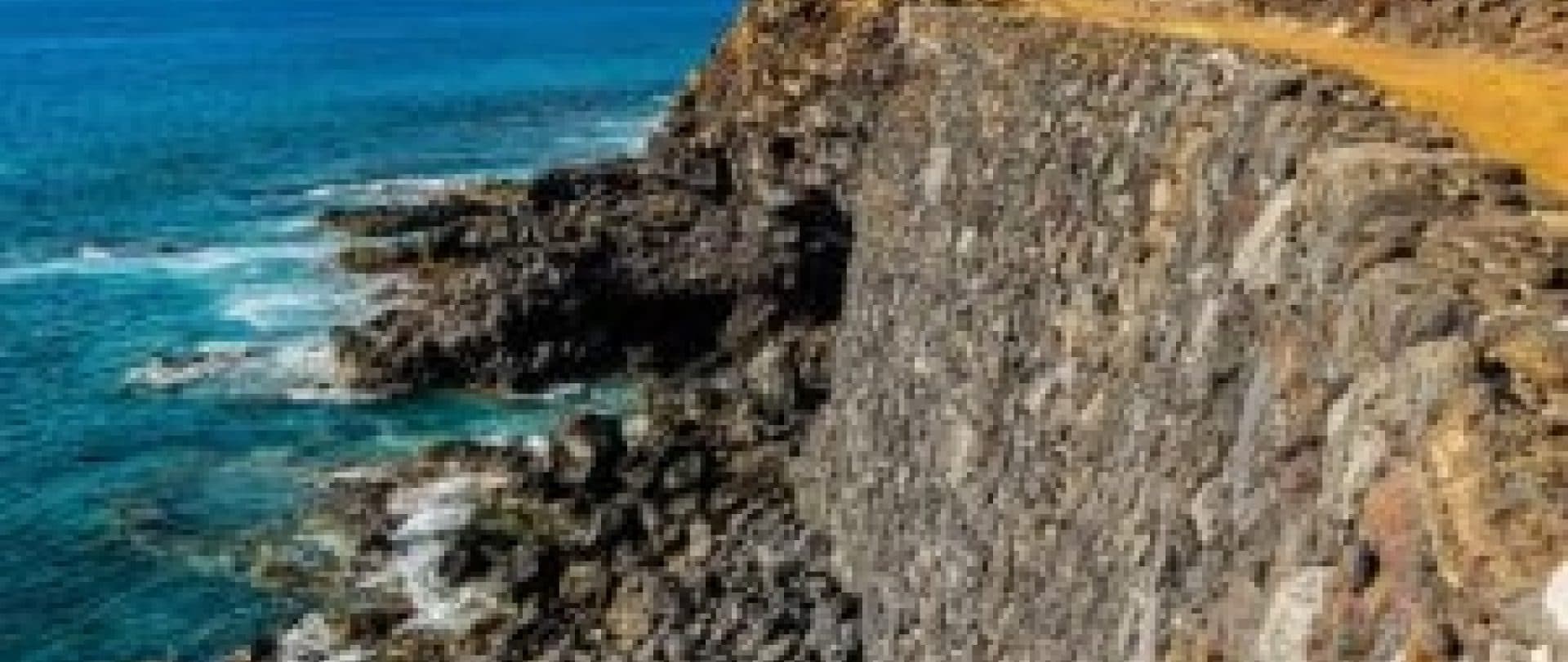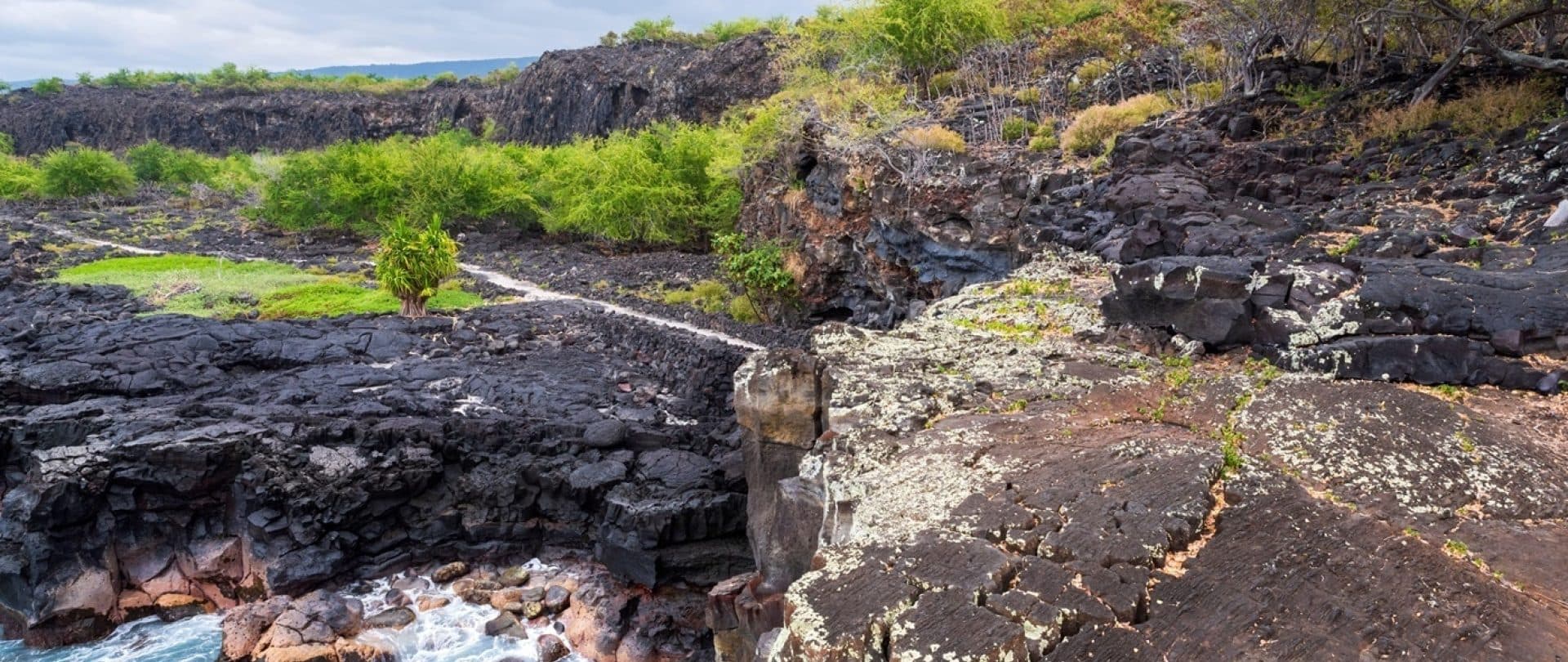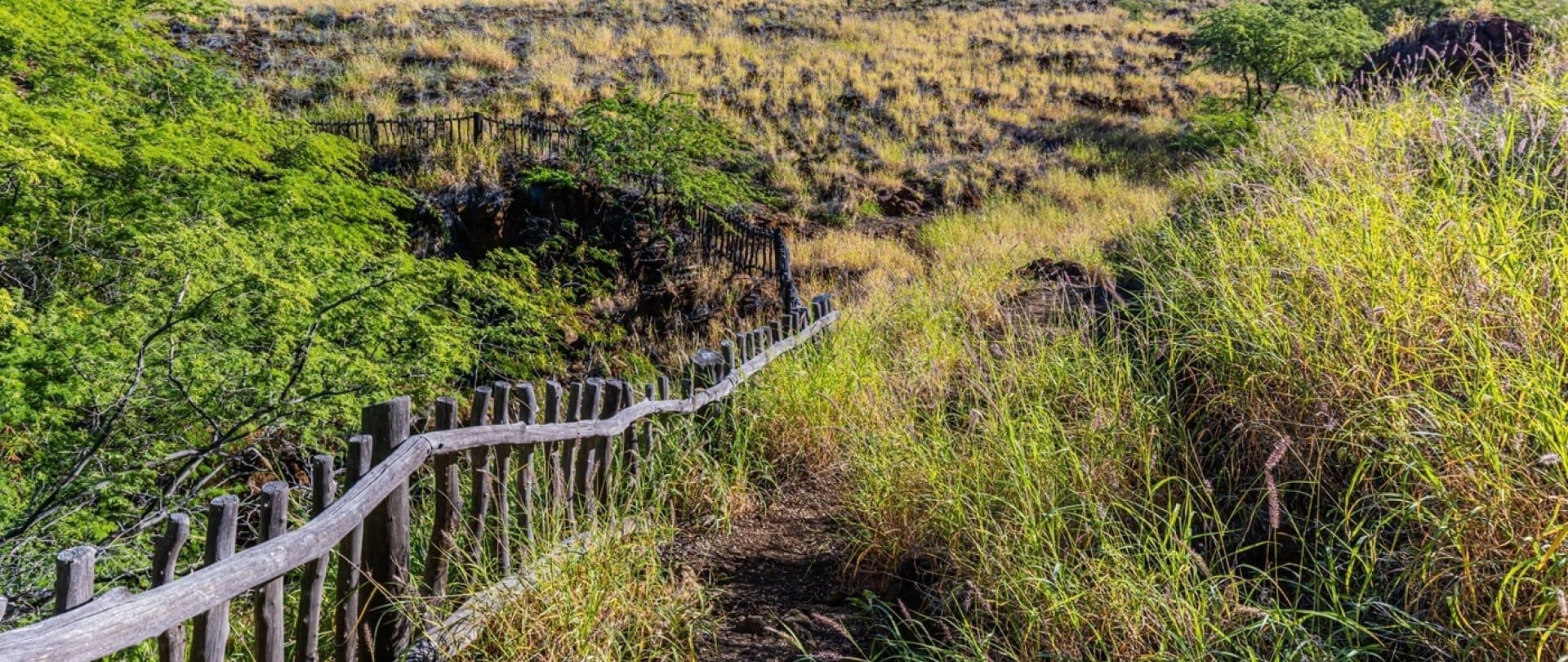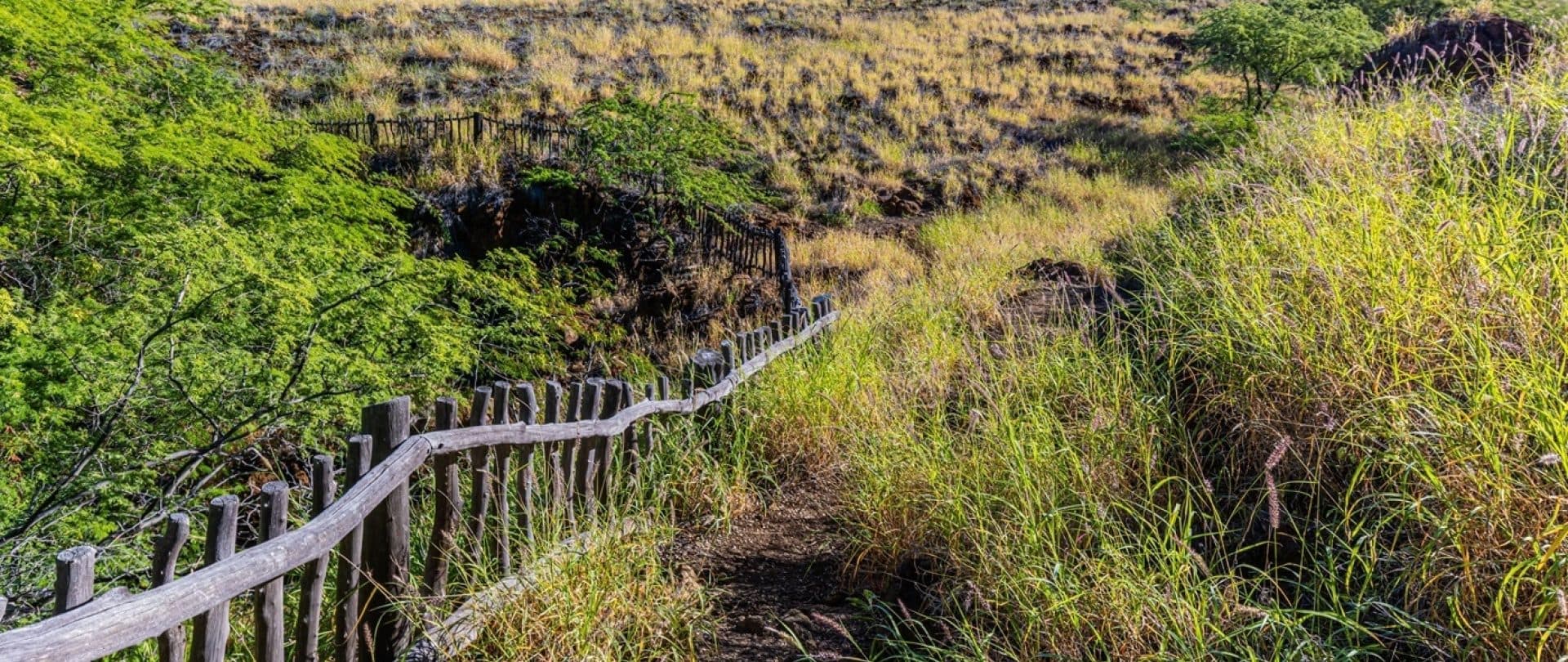Historical Hike
Explore the path connecting the present to the past and future
BY Sara Stover
Winding over rugged lava fields and along the breathtaking coastline of Hawai‘i Island, Ala Kahakai National Historic Trail is nearly 175 miles long. The corridor runs from ‘Upolu Point on the island’s northern end down the Kona Coast, before curving around South Point and meandering to the eastern boundary of Hawai‘i Volcanoes National Park, and all the way to Puna.
Ala Kahakai’s trail system is at once a network connecting Hawai‘i Island’s shoreline trails to the mauka (mountain) and makai (ocean) trails and a bridge connecting the present to both the past and future. For centuries, Hawaiians living in different ahupua‘a have trekked by foot on these carefully planned, built and maintained trails.
In ancient Hawaiʻi, each island was split into wedge-shaped land divisions called ahupua‘a. Running from mauka to makai, each ahupua‘a contained all necessary resources for functioning as a self-sufficient community. Here, families lived, promoted traditions and instilled the value of caring for one another and the ‘āina (land).
As you traverse Ala Kahaki’s the coastal trail, listen and you just might hear whispers of a civilization that not only settled upon this dry, exposed land but thrived here. Ancient Hawaiians chose to call the barren lava fields home because of the presence of cool, brackish water springs—proof there was enough of an underground water source to sustain their everyday needs. Also, a factor in this choice was a spirit they felt in every tree and rock, in the sand and surf of the bays and in the trade winds that swept across the island. Touched by the trail’s mana (power), Hawai‘i’s coastal settlers embraced this spirit. They lived so harmoniously with the land that it became part of their existence, making a separation between nature and culture nonexistent. When on the trail, be open and you too may sense the same spirit.
It is perhaps this prevailing spirit that moved Queen Lili‘uokalani to approve the Highways Act of 1892, which still defines the role of trails in Hawai‘i’s communities today. Lili‘uokalani deemed all trails built before 1892 be open to the public as property of the Hawaiian Kingdom.
Throughout the years, Ala Kahakai has faced many challenges, including development on or near the trail corridor. In some instances, developments have even been built over the trail. Also taking their toll are erosion and lava flows. Recognizing the need to preserve the historic trails and protect natural areas adjacent to the trails, Hawai‘i Island-based non-profit E Mau Na Ala Hele has been advocating for the protection, preservation and perpetuation of the trails for decades. In 2000, the non-profit succeeded in attaining federal designation of Ala Kahakai as a National Historic Trail. Since then, Ala Kahakai National Historic Trail has been administered by the National Park Service.
“This shoreline trail is unique in that it models the intersection of cultural perpetuation, environmental stewardship and values-based economic development,” says Aric Arakaki, Ala Kahakai National Historic Trail Superintendent. “To walk on and maintain the trails is a traditional cultural practice.”
When you travel on Ala Kahakai National Historic Trail, you’re on more than a recreational path. You’re moving along historically significant routes, passing important natural areas and ecosystems with indigenous plant and animal species, anchialine pools, caves, ecological zones and lava formations, all of which represent fundamental components of Hawaiian culture and call for preservation.
While there are dozens of spots to begin your Ala Kahakai experience, a popular starting point is the Waikoloa Petroglyph Preserve. Ancient Hawai‘i crosses paths with modern Hawaiʻi in the Waikoloa Beach Resorts, where you can pick up the Kīholo-Puako trail, which is also known as the Kingdom Road. Part of the Ala Kahakai National Historic Trail system, Kīholo-Puako is a 3.5-mile out-and-back trail leading to one of the island’s best-preserved petroglyph sites. Thousands of ki‘i pōhaku (petroglyphs) are scattered everywhere and believed to identify the border between the ancient kingdoms of Kona and Kohala. While we can only speculate as to what the ki‘i pōhaku mean, following in the footsteps of the ka po‘e kahiko (people of old) who created the carvings may widen our window into their world.
The adage “the journey is the destination” holds true when it comes to traveling on the “trail by the sea.” As you hike the various sections of Ala Kahakai, consider the crushed lava crunching beneath your feet a reminder that in 1801, Hualālai erupted, and lava flowed from the island’s third most active volcano to the ocean below. On a clear day, drink in the beauty of Kohala Mountain, an extinct volcano that is about one million years old —old enough to have experienced and recorded the reversal of the planet’s magnetic field 780,000 years ago.
With wide open skies above you, expansive views of the ocean and stretches where only the seabirds interrupt the tranquility and spiritually significant structures along the way, Ala Kahakai National Historic Trail is an ideal hike for anyone seeking time for self-reflection and communion with nature and the sacredness of the trail’s spirit. Remnants of Hawaiian places of worship like the Pu‘uoina Heiau at Kaloko-Honokōhau National Historical Park and the Pu‘ukoholā Heiau near Spencer Beach, as well as St. Peter’s Church-by-the-Sea on Ali‘i Drive and the Hokuloa Church in Puakō are also found along the trail.
Ala Kahakai passes through four national park units, including Pu‘ukoholā National Historic Site, Kaloko-Honokōhau National Historical Park, Pu‘uhonua o Hōnaunau National Historical Park and Hawai‘i Volcanoes National Park. And for families, the national parks are a perfect place to access the trail. Start your time on the trail by stopping by the park’s Visitors’ Center to pick up an Ala Kahakai brochure and a Junior Ranger book. Be sure to visit one (or all!) of the parks and complete the ranger activities with your kids. And if your family are Passport to Your National Parks’ book holders, you can get your books stamped at each of the national parks.
In addition to national parks, Ala Kahakai National Historic Trail connects six state parks, 11 county parks, over 200 ahupua‘a and wahi pana (storied landscapes) while offering a deeper understanding of Hawaiʻi Island’s natural resources, heritage and ceremonies. Ultimately, the trail overcomes disparity by connecting us to each other.
“Ala Kahakai is a network of trails that is part of the movement of people across the planet. We all have this in common. All our ancestors traveled along trails, by land and sea, and that’s how we got to where we are today. Ala Kahakai celebrates our diverse backgrounds while recognizing the commonalities that unite us,” Arakaki points out.
He also reminds anyone traveling the coastal corridor to respect Ala Kahakai and those you share the trail with. Many lineal descendants still use the system to reach the shore where they fish, pick ‘opihi and harvest sea salt, much like their ancestors have done for generations.
To ensure that communities connected by Ala Kahakai National Historic Trail are safe, no matter who uses the trail, a law of the Hawaiian Kingdom remains in place to this day. Kānāwai Māmalahoe, or Law of the Splintered Paddle, is a precept in Hawaiian law enacted by King Kamehameha I in 1797 to provide protection for travelers along the trail. Establishing the King’s claim that all who traversed the trails were guaranteed safe passage, and that no one woman or man should be harmed when traveling from place to place, the law is enshrined in the state constitution and encourages present day use of the trail system. Additional laws protect the Waikoloa Petroglyph Preserve and other archaeologically significant sites of Ala Kahaki. Out of respect, and for your own safety, stay on the trail and in the designated viewing areas.
The lava rocks and sun can prove treacherous at times, so travel across the uneven terrain with care and wear sturdy shoes that you are comfortable in. Be prepared by bringing water and a snack, since there’s a good chance you will want to spend more time on the trails than you planned to. And don’t forget your sunscreen! No matter which section of Ala Kahakai you choose to visit, go with good intentions and tread lightly. Never take any rocks, sand, shells or plants from the trail, and always take home anything you brought onto the trail.
Respect Ala Kahakai National Historic Trail’s living history by taking the time to read markers along the way and learn about Hawaiian culture with humility. And heed any signs about park and trail closures at dusk and dawn. Above all, plan and remember that although Ala Kahakai can be accessed at several sections along the island’s coastline, it is not a single, continuous trail at this time. For an immersive, safe experience, consider participating in Ala Kahakai Trail Association’s events, which include “Along the Ala Kahakai Trail,” a talk story series starting at Hokuloa Church, and the Kaunamano Community Hike. You can also give back by volunteering at the next Waikapuna Community Volunteer Day and supporting organizations such as E Mau Nā Ala Hele and Ala Kahakai Trail Association.
The Ala Kahakai National Historic Trail system was and will always remain dynamic. It serves as a path to a sacred connection to Hawai‘i and the ancestors whose spirits live on through the land.
Ola i ke ahe lau makani — “Life is in a gentle breath of wind.”
As you travel the trails, make the most of these connections and let this gentle wind remind you what a precious gift life truly is.
Learn more about Ala Kahakai National Historic Trail at nps.gov/alka/index.htm. Learn more about Ala Kahakai Trail Association at alakahakaitrail.org and E Mau Nā Ala Hele at emaunaalahele.org.




